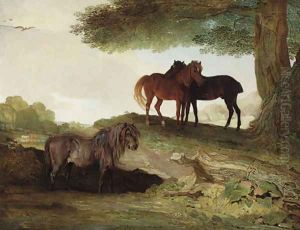Ben Marshall Paintings
Ben Marshall was a British artist known for his portraits, particularly those of racehorses and their riders. Born in Seagrave, Leicestershire, England, in 1768, Marshall developed an early interest in painting and horses, combining these passions to become one of the notable equestrian artists of his time.
Marshall began his career as an artist by studying under the landscape painter William Pether. He later moved to London to further pursue his artistic career, and it was there that he began to establish himself as a portraitist, painting both people and animals with a particular focus on the horse racing world. His works were characterized by their accuracy in depicting the anatomy of horses and the lively representation of the racecourse.
During his career, Marshall exhibited at the Royal Academy between 1800 and 1819. He gained a reputation for his lively and accurate portrayal of racehorses, which won him commissions from prominent members of British society including horse owners and breeders who wanted to immortalize their prized animals and victories. These portraits were not only important as works of art but also served as historical records of significant racehorses and events in the racing world.
Marshall's attention to detail and ability to capture the essence of the horses he painted helped to elevate the status of equine portraiture. His style was somewhat more realistic and less idealized than that of his contemporaries, which added to the unique nature of his work. Despite being well-regarded for his equestrian portraits, Marshall's work also included landscapes and portraits of people, showing a versatility that went beyond his most famous subject matter.
Ben Marshall's legacy lives on through his contributions to British equestrian art, and his paintings continue to be appreciated for their historical value and artistic merit. His works can be found in various art collections and have also been referenced in literature pertaining to the history of horse racing and equestrian art. Marshall passed away in 1835, leaving behind a body of work that continues to be celebrated by art historians and equestrian enthusiasts alike.





